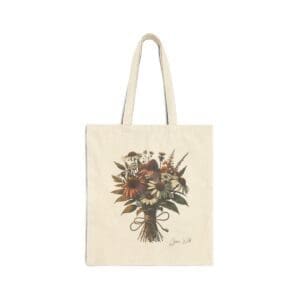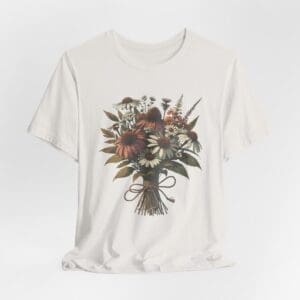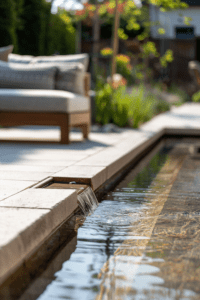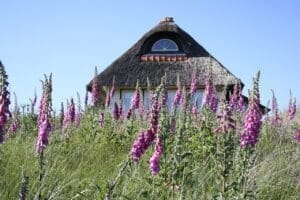Pergolas and arbors are both fantastic additions to any garden, offering a lovely touch of charm and practicality. Although they’re similar in giving shade and helping climbing plants grow, they have their own special traits. In this article, we’re going to explore what makes pergolas and arbors different, highlighting how they each shine in their own way.
| Feature | Pergola | Arbor |
|---|---|---|
| Size | Spacious design, extends over several feet. | Compact, typically 6-8 feet in height and width. |
| Structure | Robust with sturdy posts and horizontal beams; open roof structure. | Standalone small structure often with an arched roofline and trellis sides. |
| Purpose | Provides partial shade and defines outdoor seating areas like patios | Decorative elements which can create seating areas, focal points or cover pathways. |
| Aesthetic | Imposing, with a strong architectural presence. | Intimate charming secluded arch or seating area. |
| Plants | Ideal for climbing vines along its open roof. | Supports vines climbing over its arched roof. |
| Materials | Commonly made from wood, metal, or stone. | Primarily wood, though metal and other materials are also used. |
| Maintenance | Requires regular checks for rot and decay; involves managing overgrown vines. | Similar to pergolas but easier due to its compact size. |
What is a Pergola?
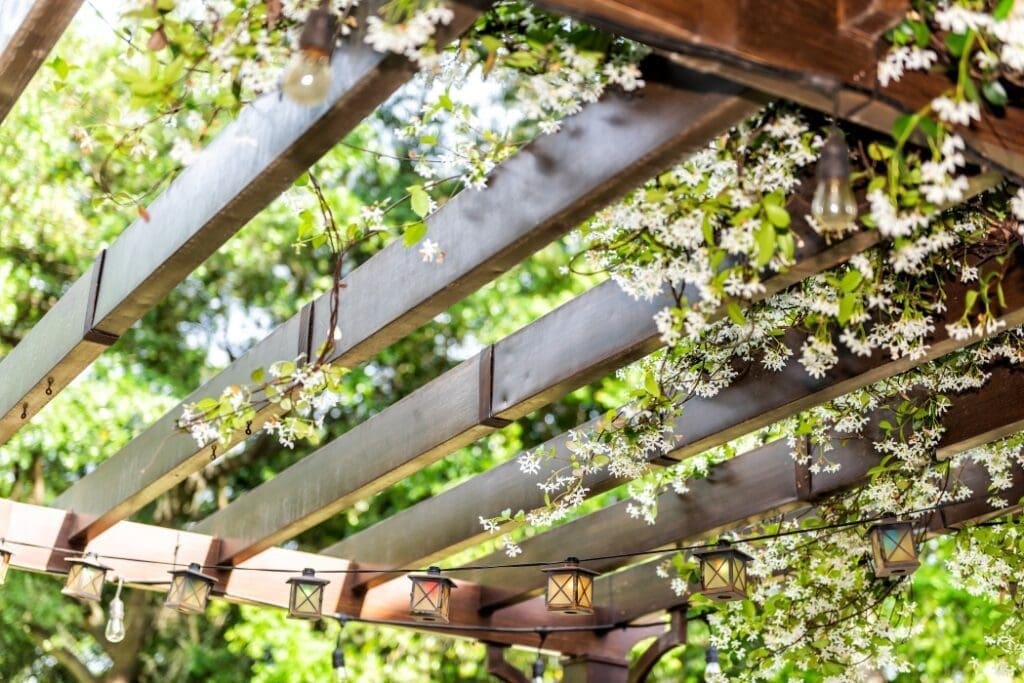
A pergola is not just a beautiful structure in your garden; it’s a piece of architectural art. Recognizable by its vertical posts and horizontal beams, it forms arch-like shapes that bring a classic elegance to any garden. The striking design of a pergola creates a rhythmic pattern, playing with light and shadow to produce a relaxed yet elegant ambiance.
One of the best aspects of pergolas is their open-air design. This design allows just the right amount of sunlight to filter through while providing good ventilation, creating a space that’s both bright and welcoming. It’s this blend of functionality and openness that makes pergolas so special. They let breezes flow through, offering moderate shade and making them perfect for a variety of uses. You can employ them as shade structures over patios, pathways, cosy seating areas, alfresco dining spaces, secluded relaxation nooks, or even as frameworks for small garden plots or water features.
In terms of materials, pergolas are incredibly versatile. You have the option of choosing from wood types like cedar and redwood, which are naturally resistant to rot and decay and mature beautifully over time. For a more contemporary look, metal pergolas made from wrought iron or aluminium are excellent choices. These materials are not only durable and weather-resistant but also add a sleek, modern profile to your garden.
You might also be interested in: Building Your Own Budget Pergola: A Complete Guide
What is an Arbor?


Arbors are not just a one-size-fits-all garden feature; they come in a delightful variety of designs. Some arbors include built-in seating, creating a cosy, secluded spot for relaxation right in the heart of your garden. Imagine sitting surrounded by fragrant climbing roses or sweet honeysuckle, enjoying a moment of tranquillity. These seated arbors are perfect for those who love to immerse themselves in the beauty and serenity of their garden.
On the other hand, many arbors are designed to act more like archways, forming enchanting gateways that lead you into new parts of the garden. These archway-style arbors are often used to mark transitions between different areas, like from a manicured lawn to a wildflower meadow or a vegetable patch. They add a sense of mystery and anticipation, inviting visitors to explore and discover what lies beyond.
Whether you choose an arbor with a seat for a quiet reading nook or an archway-style arbor as a grand entrance to your garden’s next chapter, each design adds its unique charm and functionality. Arbors, in all their forms, are versatile elements that can transform the character of your garden, making it a more inviting and enchanting space.
Differentiating the Two: Pergolas vs Arbors
- Size and Scale:
- Pergolas are typically larger and more expansive, suitable for covering bigger spaces.
- Arbors are generally smaller and more compact, ideal for fitting into smaller garden spaces.
- Structural Design:
- Pergolas have a flat, open roof supported by sturdy columns or posts.
- Arbors often feature an arched or curved roof, creating a gateway-like appearance.
- Functionality:
- Pergolas are used to provide shade over patios, decks, or walkways and can be freestanding or attached to buildings.
- Arbors are primarily used as decorative elements, often marking the entrance to a garden or a distinct garden area.
- Aesthetic Appeal:
- Pergolas offer a bold, architectural statement, often serving as a focal point in garden design.
- Arbors provide a romantic, whimsical charm, enhancing the garden’s visual appeal with their delicate structure.
- Integration with Plants:
- Both structures support climbing plants, but pergolas offer more space for plants to grow due to their larger size.
- Arbors are ideal for smaller climbing plants and can create a blooming archway effect.
- Seating Options:
- Some pergolas are designed with integrated seating areas or are large enough to accommodate garden furniture underneath.
- Arbors may also feature built-in benches, offering a cosy nook for relaxation within the garden.
While both pergolas and arbors are fantastic for supporting climbing plants, they each bring something different to the garden with their unique sizes and structures. This makes them suited to different spaces and design visions.
Pergolas, with their open roofs and strong posts, are perfect for covering larger areas like patios and walkways. They’re not just functional; their impressive size and structure make them stand out as sculptural elements in your garden. On the other hand, the charming arbor, often smaller in scale, wins hearts with its arched design. It fits beautifully into garden beds or acts as a picturesque frame for garden views.
The real beauty lies in the contrast between these two structures. Pergolas have a soaring, majestic profile that commands attention and adds a sense of grandeur to any space. Arbors, with their delicate curves, offer a more romantic, graceful touch. Each brings its own design flair to the garden – the pergola with its bold presence and the arbor with its enchanting elegance.
Embrace the Beauty of Climbing Plants
Both pergolas and arbors are perfect for showcasing stunning climbing plants. Imagine roses, clematis, wisteria, and jasmine turning these structures into lush, green sanctuaries.
🌿 Related Post: Don’t miss our article on ‘7 Of The Best Plants For Pergolas‘ for more inspiration!
The lattice work on pergolas and the arched openings of arbors provide the perfect support for these vines. They cling and climb, creating a natural tapestry that softens the structures’ edges. This vertical greenery not only looks enchanting but also casts beautiful shadows, adds gentle movement, and fills the air with sweet scents.
Think of the full blooms of roses, the elegant cascades of clematis, the sweet aroma of star jasmine, or the enchanting drapes of wisteria blossoms. The options for creating a vibrant plant display are limitless. With seasonal flowering vines, your garden can enjoy continuous bursts of colour. And for a touch of green throughout the year, evergreen varieties like variegated ivy are perfect.
Whether it’s adorning an arbor’s entrance or creating a leafy haven around a pergola, climbing plants add a dynamic and lively element to these garden structures. Their growth is a beautiful display of nature’s rhythms, changing and evolving through the seasons, from spring’s fresh beginnings to autumn’s rich tapestry.
FAQs: Pergolas vs Arbors
Q. What is the main difference between a pergola and an arbor?
The main difference lies in their size and function. Pergolas are larger structures often used to cover patios or walkways, providing shade and space for outdoor living. Arbors are smaller, typically used as decorative elements, often marking entrances or pathways in a garden.
Q. Can I grow any type of climbing plant on a pergola or arbor?
Most climbing plants can thrive on pergolas and arbors, but it’s important to choose plants that suit your climate and the structure’s material. Popular choices include roses, clematis, wisteria, and jasmine.
Q. How do I maintain a wooden pergola or arbor?
Wooden structures should be regularly checked for signs of wear, such as splinters or rot. Apply a fresh coat of paint or sealant every few years to protect the wood from the elements.
Q. Are pergolas and arbors suitable for small gardens?
Absolutely! While pergolas might be too large for very small spaces, arbors are perfect for adding charm to smaller gardens without taking up too much space.
Q. Can I install lighting or decorations on my pergola or arbor?
Yes, you can enhance your pergola or arbor with lights, fabric, or other decorations. Just ensure that any additions are securely attached and suitable for outdoor use.
Final thoughts
While pergolas and arbors may share some similarities, it’s their differences in size and structure that really highlight their unique characters. Pergolas bring a sense of height and drama to your garden, creating an impressive presence. On the other hand, arbors captivate with their intricate details and quaint size, adding a touch of whimsy.
What unites these two structures is their love for lush, climbing plants. They both have a way of transforming gardens around the world, adding layers of beauty, mystery, and depth. Whether draped in greenery or standing alone, they make a statement.


